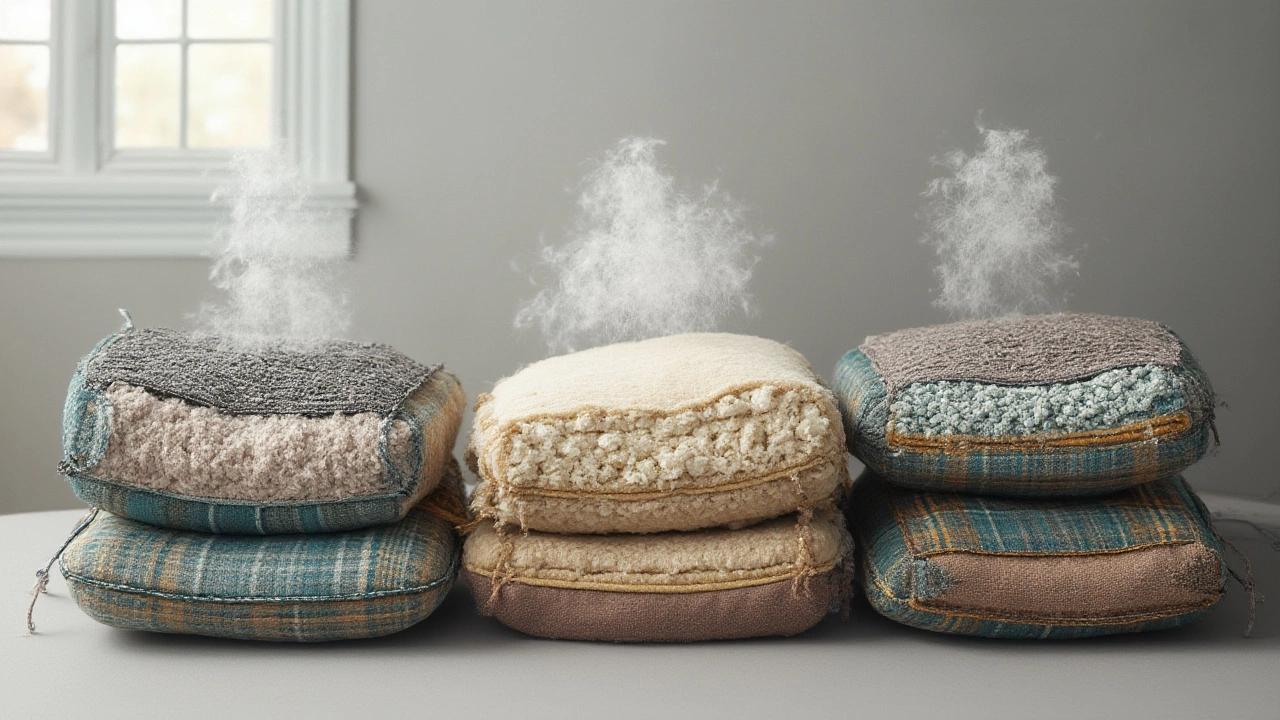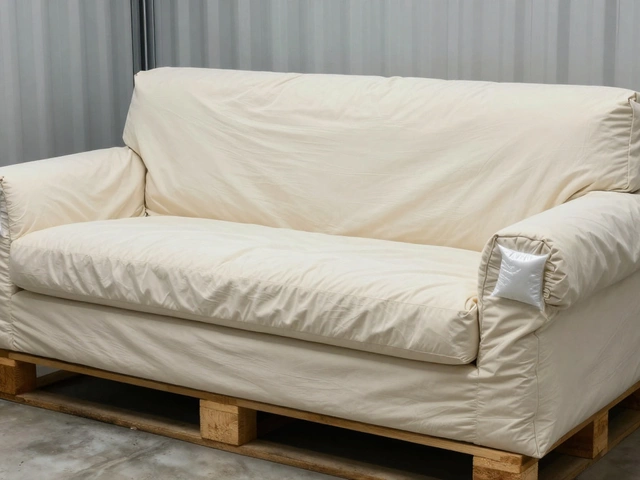Ever flopped onto a saggy sofa and sworn never to buy a couch like that? You’re not alone. Most people only think about cushion comfort for the first few months, but the real headache sets in after a couple of years—when lumps, dips, and pancakes start creeping into your seat. Here’s where the secret lies: what’s inside (and outside) your couch cushion matters way more than the price tag or the brand hype. A lot of big retailers won’t mention cushion durability, but it’s what separates a six-month letdown from a ten-year winner. If you’re tired of flattened seats and wasting money on a new couch every time, stick around. Understanding the science and common-sense tips about cushions can rescue you from the endless couch upgrade cycle.
What’s Inside: The Materials That Make or Break a Cushion
When it comes to finding the longest lasting couch cushions, materials are the entire ballgame. Most cushions use one of three main types of fill: polyurethane foam, feather/down, or polyester fiber. The real surprise? Your instincts about which ones hold up could be totally off. Polyurethane foam has been the household standard for decades. Within that, foam comes in different grades and densities, and this is where most buyers get tripped up. Low-density foam (sofa manufacturers love calling it “softer” or “plush”) feels great in the store but collapses fast—sometimes in less than a year. High-density foam (around 1.8 to 2.5 lbs per cubic foot) keeps its shape, absorbs less body weight, and springs back, even after thousands of hours of sitting. A 2019 Consumer Reports test found that high-density foam’s resilience extended cushion life by up to 50% compared to mid-range blends. The difference is night and day.
But foam isn’t the whole story. Feather and down fills—the soft, sink-in ones—are often hyped as luxury, but what no one tells you: they need fluffing and maintenance just to avoid pancake syndrome. Down cushions break down under body weight, trapping air when new but losing support over time. Polyester fiber is the usual budget pick. It’s hypoallergenic and soft, but compresses quickly, often within months. No magic here—poly fill is cheap for a reason.
If you want true longevity, look for combinations: a high-density foam core wrapped with a thin layer of down or poly batting. This hybrid keeps structure but gives you the cozy wrap-around feeling. As a bonus, hybrid cushions are about 75% lighter than full down but don’t sag nearly as fast. Gone are the days when sofas were heavy enough to anchor a boat—but unless you like re-fluffing, hybrids beat all-down for actual day-to-day living. If you can hold the cushion and it bounces right back, you’re headed in the right direction.
| Cushion Fill Type | Average Lifespan (Years) | Maintenance Level |
|---|---|---|
| Low-density Polyurethane Foam | 1-2 | Low |
| High-density Polyurethane Foam | 5-10 | Very Low |
| Feather/Down | 3-5 | High (Frequent Fluffing) |
| Polyester Fiber | 1-2 | Low |
| Hybrid (Foam Core + Down/Poly Wrap) | 7-10 | Medium |
Another secret that furniture salespeople rarely share: foam wrapped in down or poly batting not only lasts longer, it actually holds its shape. No lumpy corners, no odd sags where your dog likes to nap. It’s a little more expensive, but the payoff is you’ll stop fiddling with your cushions every time you sit down. One warning: never fall for “recycled foam crumb” as the main fill. It’s often used in cheaper couches, but it breaks down super quickly, turning your cushions into a sad pile of crumbs. If you see a zipper on the cushion, peek inside if you’re at the store next time—you’ll learn a lot more in two seconds than from any price tag.

Covers and Construction: Why the Outside Matters Too
It’s not just about what’s on the inside. If your cover material is weak or poorly constructed, even the best foam will wear out fast. The cover takes all the abuse—spills, pets, jeans rivets, naps, endless movie nights. For a cushion that goes the distance, always check the fabric quality and construction first. Here’s what you really need to know: tightly woven, heavy fabrics (think twill, denim, or quality canvas) can seriously outlast the synthetic microfiber or thin poly blends found on cheaper sofas. “Rub count” or “double rub” numbers matter here—a fabric rated 40,000 double rubs or more is considered commercial grade and can handle aggressive daily use.
But stitch work might be even more important than the actual fabric. Loose threads, single-stitched seams, or poorly finished edges are the first places you’ll see damage. If you need something family- and pet-proof, go for double-stitched seams and piped (corded) edges. These little construction details actually spread out stress and keep the seams from busting open after a year of real living.
Removable, zippered cushion covers are not just convenient for cleaning. They also tend to last longer because you can flip them, rotate them, and, when needed, toss them in the wash. It sounds simple, but people who actually use these design tricks regularly see their couches last years longer. In fact, there’s a 2021 upholstery study showing that sofas with removable covers and flipped cushions had an average usable life of eight years—twice that of fixed-cushion couches under daily use.
If staining is a worry (kids, wine nights, pets), microfiber actually does hold its own. It resists soaking in stains, and because it’s tightly woven, it doesn’t wear through in the same spots as fast as you think. Leather (real leather, not “bonded leather” or “PU leather”) is even tougher, but you’ll need to occasionally condition it or it’ll crack and get brittle. Bonded or faux leathers, on the other hand, can peel and flake after just a year or two. It’s always tempting because faux saves a lot of cash upfront, but the looks rarely last long. Breathable wool and linen also surprise people. They’re pricey and need a little care, but their toughness is next-level—just check the seats at any high-end hotel lobby. If you want your couch to survive heavy daily use, seriously think about investing in a tough exterior.
Construction tips make a gigantic difference. Never buy a couch where you can’t flip or rotate the cushions—those fixed-seat styles might look sleek, but they wear out exactly where you sit the most. Check the zipper quality. A good metal zipper will probably outlive the cushion, while cheap plastic ones stick or break, locking in stains forever. Little things, big difference.

Savvy Buying and Real-World Tips: Make Your Cushion Investment Last
So how do you actually take this knowledge to the store (or website) and walk out with something that pays off year after year? First, start with density and ask questions. Don’t be embarrassed to unzip a cushion and see what’s inside. If you see “HR foam,” “high-resilience foam,” or a density above 1.8 lbs/ft³, you’re getting the stuff pros use in durable seating—think restaurants or waiting rooms. Don’t expect salespeople to volunteer this; sometimes you need to push to get the real details. If you’re buying online, read the fine print and make sure the seller lists fill type and density, not just “premium foam.”
Next, actually sit—hard—on the cushion. Stand up, check if it bounces back. High-quality foam recovers quickly and doesn’t leave a dent. Try the “pinch test”—grab the cushion and press your fingers together from opposite sides. If you can pinch it flat, it’s too soft and likely won’t last. Some higher-end stores will have density samples or tags; ask to see or touch those.
Watch out for common marketing traps. Fluffy, pillow-top style cushions look inviting, but if the fill is cheap, they pancake fast. Feather/down blends without a foam core will give you that “melt-in” feel, but expect to fluff them constantly. Some people love that sink-in style, but if you just want a cushion you can forget about until laundry day, hybrids or solid high-density foam are simply tougher.
Care makes a real difference. If you rotate and flip your cushions every month, you spread wear evenly, which doubles their lifespan. Vacuuming cushions regularly doesn’t just keep them clean, it also keeps abrasive dirt from cutting into the fibers. Spills? Blot quickly—don’t rub—and if possible, remove the cover for a proper wash. A little detergent with enzyme cleaner gets out most organic stains without nuking the fabric strength. And no matter what, keep your new sofa out of direct sunlight. UV rays fade and weaken just about every cover fiber, even the best ones, and foam gets brittle under heat.
A lot of new brands now offer “lifetime cushion warranties,” but there’s a catch: read the fine print. Most only cover manufacturing defects, not normal wear or dog wrestling matches. Still, a 5- or 10-year cushion guarantee is a sign the company actually believes in what they’re selling. When cushions are special-order instead of mass-produced for fast shipping, that’s another reliability hint.
And maybe the biggest thing most buyers forget: quality weighs more. A truly robust seat cushion will simply feel heavier. That’s density, and density is your friend. The more cushion you get per square inch, the less sag you’ll see in the future.
- Ask for cushion fill details before you buy—density, materials, and blend matter more than looks.
- Always choose washable, removable cushion covers if possible. They massively extend couch life.
- Rotate and flip cushions at least once a month to even out wear.
- Avoid direct sunlight if you want your covers and cushion fills to last longer.
- Don’t fall for “too good to be true” sales on unbranded sofas, especially if they feel weightless or too soft.
Here’s the bottom line: If you want a couch that stays comfortable and keeps its shape for years, skip the marketing noise. Pay close attention to high-density foams or well-made hybrids, double-stitched covers, and a simple routine of rotating and cleaning. These choices aren’t complicated, and they don’t need a massive budget. They just work. Your future self’s back—and wallet—will thank you.




